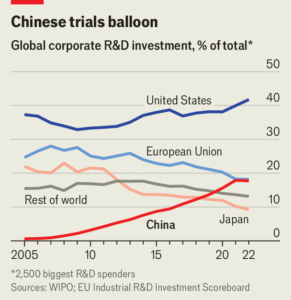
Your browser does not support the <audio> element.
If autonomous cars are supposed to make life easy, then Apollo Go, the robotaxi unit of Baidu, a Chinese tech giant, still has work to do. When your correspondent tested its service in the city of Wuhan he had to find his way to a designated pick-up location and end his journey at an approved drop-off spot—more like taking a bus than a cab.
Yet Apollo Go, which launched in Wuhan in 2022 and has since expanded to ten other Chinese cities, has been a hit. Its service has carried out 6m rides nationwide since launching. It now has more than 400 driverless cars on the road in Wuhan and plans to have 1,000 running by the end of this year. Chinese carmakers including Hongqi and Arcfox make the vehicles for Baidu, which provides the technology. Most of its cars in Wuhan have “level four” autonomy, which means they do not require human intervention in most situations on the road but can get muddled in areas such as parking garages—which might explain why it asks customers to trudge through the city’s sweltering heat.
The reason Apollo Go has, nevertheless, gained such favour with riders is that it is astonishingly cheap. Your correspondent’s 11-minute spin cost just 9.84 yuan ($1.35). Such fares are possible thanks to the largesse of Baidu, which is covering around 60% of the cost of a ride. That is not sustainable. But, thanks to plummeting costs, the company reckons its robotaxis in Wuhan will break even by the end of the year and turn a profit in 2025.
Drivers account for about half of the total cost for a conventional ride-hailing service. But an assortment of other expenses associated with autonomous vehicles—from maintenance and cleaning to sensors and, most importantly, the software on which they run—have so far prevented them being a cheaper substitute. Baidu sees that changing. In May it unveiled its sixth-generation vehicle, which costs less than half the previous model, and plans to upgrade the fleet in Wuhan. As the business has expanded the supply chain has matured and Baidu has been able to spread the cost of developing and updating its technology over more vehicles.
One group that is not thrilled by Baidu’s success is Wuhan’s cabbies. When asked whether taxi drivers’ jobs will be affected, one insists that it “is already happening”. Another driver says he admires Baidu’s technological advances but worries his job will be “stolen”. Last month a taxi company in the city published an open letter warning of the threat that autonomous cars posed to employment.
About 10m people are employed as cabbies in China. Of those about 7m work for ride-hailing firms, in many cases after losing their jobs in another industry. It is unclear how sympathetic China’s government will be to their plight. The country’s leaders are eager to gain an edge in emerging industries. Local officials are already competing for business. In June the city of Beijing drafted a new set of guidelines for autonomous driving that HSBC, a bank, says will make regulation of the industry more “transparent and predictable”.
Elsewhere, efforts to develop robotaxis have stalled. Last year General Motors, an American carmaker, suspended operations at Cruise, its robotaxi business, after one of its cars injured a pedestrian in San Francisco, leading California to revoke its licence to operate in the state. On July 23rd it said it would relaunch the service in Dallas, Houston and Phoenix, but with a human supervisor in the vehicle.
That same day Tesla, America’s electric-vehicle giant, said it would push back the unveiling of its robotaxi from August to October. In May China’s government offered to let the company test its service in the country. If it does, expect more hand-wringing from China’s taxi drivers. ■
To stay on top of the biggest stories in business and technology, sign up to the Bottom Line, our weekly subscriber-only newsletter.



















